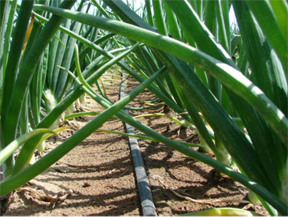Good time to review your vegetable production fertilizer practices
Producers of high input, high value crops like fresh vegetables work hard at getting maximum production efficiency. With increased fertilizer prices, it serves growers well to review their approach to fertilizing their crops.
Fertilizer represents a significant input cost in vegetable production, so it is economically important that producers review their approach to nutrient applications. The goal in applying nutrients is to insure the plant has the necessary amounts to produce maximum yield. After a soil test to determine base nutrient levels and crop needs, one of the first things to consider is application method. There are two basic approaches to nutrient application and uptake; through the roots and through the leaves.
 Roots anchor plants and take up water and nutrients dissolved in that water. This is an automatic clue as to where most nutrients should be applied to have their greatest effect: to the roots. Soil nutrient availability depends highly on pH and as long as roots and stems are healthy and soil pH near 6.5, nutrients should be applied to be taken up by roots. How they are applied depends on soil type, production practices and application technology. Sand-based soils should be fertilized a little at a time since they do not hold onto nutrients very well and are prone to leaching. This is why drip irrigation and application of fertilizers through the drip system (fertigation) is helpful on these soils. Broadcast and sidedressing of dry products will be more effective on clay-based soils, providing they have a good opportunity to get worked into the soil. Research has shown split fertilizer applications better match crop demand and reduce nutrient losses.
Roots anchor plants and take up water and nutrients dissolved in that water. This is an automatic clue as to where most nutrients should be applied to have their greatest effect: to the roots. Soil nutrient availability depends highly on pH and as long as roots and stems are healthy and soil pH near 6.5, nutrients should be applied to be taken up by roots. How they are applied depends on soil type, production practices and application technology. Sand-based soils should be fertilized a little at a time since they do not hold onto nutrients very well and are prone to leaching. This is why drip irrigation and application of fertilizers through the drip system (fertigation) is helpful on these soils. Broadcast and sidedressing of dry products will be more effective on clay-based soils, providing they have a good opportunity to get worked into the soil. Research has shown split fertilizer applications better match crop demand and reduce nutrient losses.
Foliar application has received much attention and is an important component in some situations. Some soil pH conditions require foliar applications. Such is the case in a high pH organic soil with elements like manganese, iron, copper and zinc. Plants under these conditions will certainly benefit from foliar application of these nutrients since it may be the only way to get adequate levels into the plant.
However, under most situations the majority of research trials indicate the best way to apply nutrients is through the roots since they are the plant organ best suited for uptake. Leaves are the organs of photosynthesis and are designed to assist and protect that process with waxes, hairs and thick cuticles that nutrients other than carbon dioxide have trouble penetrating. Plus, for nutrients such as nitrogen and potassium, not enough can be applied as a foliar product through the season to get maximum production for most crops. To avoid leaf burning, only about 5 pounds of nitrogen can be applied at one time and for a high nitrogen-requiring crop (corn), there is not enough time to meet the need.
Efficient nutrient application is an important factor in protecting your economic bottom line as well as the environment. So while you are waiting to get into the field, take time to review your best approach to meeting the nutrient demands of your crops.



 Print
Print Email
Email

